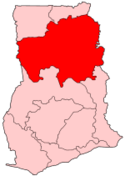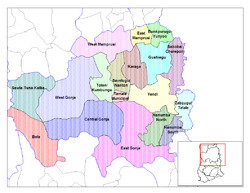- Northern Region (Ghana)
-
Northern Region Location 
Statistics Regional Minister S.S. Nayina Capital Tamale Area 70,384 km²
Ranked 1stPopulation
2000 Census
1984 CensusRanked 5th
1,820,806
1,164,583Districts 18 ISO 3166-2 GH-NP The Northern Region is the largest area of Ghana. As of 2009, it is divided into 20 districts. The region's capital is Tamale. Climatically, religiously, linguistically, and culturally, the region differs greatly from the politically and economically dominating regions of central and southern Ghana.
Contents
Geography
Central Ghana
Districts
The Northern Region of Ghana contains the following 20 districts:
- Bole District
- Bunkpurugu-Yunyoo District
- Central Gonja District
- Chereponi District
- East Gonja District
- East Mamprusi District
- Gushegu District
- Karaga District
- Kpandai District
- Nanumba North District
- Nanumba South District
- Saboba District
- Savelugu-Nanton District
- Sawla-Tuna-Kalba District
- Tamale Municipal District
- Tolon/Kumbungu District
- West Gonja District
- West Mamprusi District
- Yendi District
- Zabzugu/Tatale District
Climate and Vegetation
The Northern Region is much drier than southern areas of Ghana, due to its proximity to the Sahel, and the Sahara. The vegetation consists predominantly of grassland, especially savanna with clusters of drought-resistant trees such as baobabs or acacias. Between May and October is the wet season, with an average annual rainfall of 750 to 1050 mm (30 to 40 inches). The dry season is between about November and April. The highest temperatures are reached at the end of the dry season, the lowest in December and January. However, the hot Harmattan wind from the Sahara blows frequently between December and the beginning of February. The temperatures can vary between 14°C (59°F) at night and 40°C (104°F) during the day.
People
The Northern Region is the least densely populated area of Ghana. Most inhabitants (52%) speak a language of the Mole–Dagbani subfamily in the Niger–Congo languages. The largest ethnicities within this group are the Dagomba and the Mamprussi. The Gurma along with the Konkomba place as the largest sub-group, comprising 21% of the population. The largest individual ethnic group is the Dagomba, which constitute about a third of the population. The previously mentioned languages belong - in contrast to the groups in the South - to the Gur language family.
Religion
Over 56% of the population are followers of Islam, 21% belong to traditional religions, and 19% are Christian.[citation needed] About 3% belong to other religions.[citation needed]
Ethnic conflicts in the Northern Region
The relationship between the various ethnic groups in the Northern Region has not been continuously stable. In particular, conflicts have been smoldering for a long time between the Dagomba on the one hand and the Konkomba on the other. In the eyes of many among the dominating Dagomba, the Konkomba are landless intruders and bandits, who penetrated into the areas of the Dagomba only in the colonial ages. However, this view of the origins and history of the Konkomba in this region of Ghana is not shared by themselves, and it is not supported by the scientific research on this area, especially not by any academic writing on the Konkomba or Dagomba published before the 1994 conflict, (Konkombas, Chambas, Kusasis, Sisalas and other ethnic groups are the original settlers of the area before the arrival of the Mole-Dagbani). 1994 experienced the worst ethnic conflicts ever in Ghana. The conflict spread to other groups, and ended up with several thousand dead. Due to the continuous conflict many people have migrated out of the region. From the population of 1,820,806 in the region shown in the 2000 census, it has now decreased by about 30%.
Economy
The region is one of the least developed areas of Ghana. More than 70% of the economically active population are agricultural. The small population density is partly caused by emigration due to extreme poverty in the region.
Sources
- Districts of Ghana at statoids.com
- GhanaDistricts.com
Bogner, Artur 2000: The 1994 civil war in northern Ghana: The genesis and escalation of a tribal conflict, in: Carola Lentz & Paul Nugent (eds.), Ethnicity in Ghana. London/New York: Macmillan, 2000, pp. 183–203.
External links
Regions of Ghana Ashanti · Brong-Ahafo · Central · Eastern · Greater Accra · Northern · Upper East · Upper West · Volta · Western

Districts of the Northern Region of Ghana 
Metropolitan 
Ordinary Bole · Bunkpurugu-Yunyoo · Central Gonja · East Gonja · East Mamprusi · Gushegu · Karaga · Nanumba North · Nanumba South · Saboba Chereponi · Savelugu-Nanton · Sawla-Tuna-Kalba · Tolon-Kumbungu · West Gonja · West Mamprusi · Yendi · Zabzugu-TataleCategories:- Northern Region, Ghana
- Regions of Ghana
Wikimedia Foundation. 2010.

